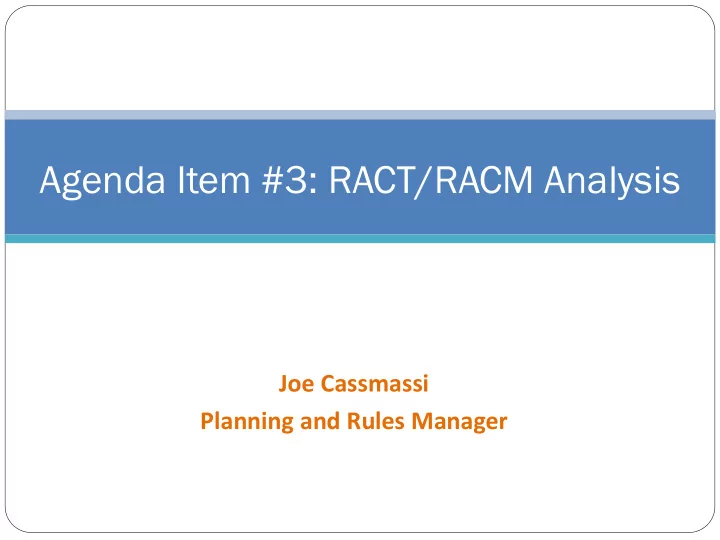

Agenda Item #3: RACT/RACM Analysis Joe Cassmassi Planning and Rules Manager
Clean Air Act Requirement Nonattainment air districts required to: “.. provide for the implementation of all reasonably available control measures (RACM) as expeditiously as practicable (including such reductions in emissions from existing sources in the area as may be obtained through the adoption, at a minimum, of reasonably available control technology (RACT))..” CAA Section 172(c)(1)
Clean Air Act Requirement • More specifically, nonattainment air districts for ozone designated as: Moderate or above : adopt RACT for major sources � Serious, severe or extreme : adopt control measure above and � beyond the minimum RACT levels to fulfill attainment CAA Section 172(c)(1) and Section 182
What is RACM/RACT? • Reasonably Available Control Measures (RACM): � Clean air measures that are technologically and economically feasible � Applicable to wide range of sources (stationary, area, mobile) � Include all RACT • Reasonably Available Control Technology (RACT) � “Lowest emission limitation that a particular source is capable of meeting by the application of control technology that is reasonably available considering technological and economical feasibility” ( 44 Federal Register §53762, September 17, 1979 )
What is Feasible? • Economically � US EPA did not propose a fixed dollar per ton cost threshold � Acceptable cost of achieving reductions could increase based on: � severity of the nonattainment areas where essential reductions are more difficult to achieve � � Should consider collective health benefits realized due to improvements • Additional Guidance � Based on current information at time of development of SIP � Considers controls achieved in practice to be feasible (economically and technologically) � Includes EPA’s Control Techniques Guidelines at minimum (CAA §182(b)(2))
U.S. EPA Proposed Implementation Guidance • U.S. EPA recommends nonattainment areas to: � Consider all candidate measures that are available and feasible � Consider measures that would advance the attainment date � Include suggested measures; however not obligated to adopt all � Demonstrate no additional reasonable measures available � Include adopted regulations in RACT SIPs (e.g., emission reduction programs already implemented at the federal, other states and local air districts)
Evaluation Process • Control Techniques Guidelines (CTGs) EPA Region IX • Alternative Control Techniques (ACTs) California • Bay Area, San Joaquin, Sacramento, Antelope Valley, Ventura AQMD/APCD Other States • Texas, New Jersey, Delaware
AQMP RACM/RACT Demonstration • Appendix VI of 2012 AQMP/2007 AQMP (ozone) • 6-step analysis 1. Air Quality Technology Symposium 2. US EPA’s suggested list of control measures 3. Reasonably Available Control Technology (RACT) 4. Other District’s current rules and regulations 5. Other District’s control measures 6. Additional studies and analyses • Conclusion � Study of more than 100 rules and 100 control measures in other air districts � Commitment to update Rule 1130 pursuant to CTG
2014 RACM/RACT Analysis • RACT SIP submittal within 24 months when attainment demonstrations were effective ( July 20, 2012 ) • Submittal due July 20, 2014 • Ongoing discussions with U.S. EPA and other AQMDs • EPA has issued no new CTGs since 2012 AQMP submittal • ~20-30 rules being evaluated from past 18 months • Intend to submit an updated 2012 AQMP RACM demonstration along with recent suggestions and rule amendments
Preliminary Results San Joaquin 4570: Confined Animal Facilities (CAF) SCAQMD i. Timeframe for feeding total mixed rations in the dairy i. Timeframe for feeding total mixed rations in the dairy feed menu is 2 hours feed menu is 48 hours ii. Regulate both large and medium CAF ii. Regulate large CAF iii. Specify both mandatory and optional mitigation measure iii. No mandatory mitigation measure San Joaquin 4311: Flares SCAQMD Cover emissions that involve the use of flares ( from refineries, oil Rules 1118 ( Refinery Flares ) and 1150.1 ( Active Landfills ) cover well, blast furnaces, coke ovens, chemical plants, etc .) flare emissions from refineries and landfills Bay Area 8-33: Gasoline Bulk Terminals and Gasoline SCAQMD Cargo Tanks Emission limits of non-methane organic compounds from a Emission limits of non-methane organic compounds from a vapor recovery system is 0.04 pound (lb) per 1,000 gallons of vapor recovery system is 0.08 pound (lb) per 1,000 gallons of organic liquid loaded organic liquid loaded AntelopeValley 1130: Graphic Arts; SCAQMD Ventura County 74.19: Graphic Arts Exemptions of certain categories with sunset dates. No sunset dates for exemptions. Ventura County 71.5: Glycol Dehydrators SCAQMD Control emissions from glycol dehydrators used in natural gas No current rule directly regulating glycol dehydrators; dehydration indirectly regulating through Rule 1148.1 ( Oil and Gas Production Wells ) and 1173 ( Leaks from Petroleum Facilities )
Submittal Schedule July ‐ Submit to EPA June ‐ Board approval ‐ Submit to CARB May ‐ Regional public hearings April ‐ Advisory Group
Recommend
More recommend